Decentralized energy receives less funding than utility-scale projects, indicating a need to rethink policy, says a new report by the International Institute for Environment and Development (IIED).
“Unlocking Climate Finance for Decentralised Energy Access” analyzes information from the Climate Funds Update database, which offers information on public finance for all major international climate funds.
About 40 percent of climate finance funds–about $5.6 billion–are earmarked for energy projects, the report says. However, only about 3 percent of that amount–or $475 million–is allocated specifically for off-grid energy. That’s about $51 million annually between 2006 and 2015.
In 2011, the IEA estimated that about $23 billion in additional financing is needed for decentralized energy access. But only 0.2 percent of that amount is actually allocated to decentralized energy, the report says.
“Most of the USD 5.6 billion of international public finance allocated for energy is going toward large scale energy and to high and middle income countries,” the report says. And over half, or $2.8 billion goes to grid-connected, or utility-scale projects.
Solar, wind and geothermal technologies get the biggest share of climate-change financing in the energy sector, the report says.
Challenges to funding decentralized energy include how funding programs are designed and a lack of new funding sources, the report says.
Why decentralized energy receives less funding
“One blocker is that international climate funds do not have the right instruments or design elements that would enable them to prioritize decentralized energy access,” says the report. “This suggests that climate finance architecture needs to be reformed to support decentralized energy access.”
What’s more, project developers need to find new funding sources, the report says.
“The data shows the biggest international climate funders are the clean technology funds (CTFs) which are using concessional loans to finance utility-scale projects in middle income countries.”
What this means, the report says, is that those who are funding climate change projects are seeking out “viable projects that will assure returns from credit-based investments.” Utility-scale projects offer better returns from loans and lower transaction costs, as compared to what’s involved in funding large numbers of smaller, decentralized projects.
Because decentralized energy is an emergent sector that hasn’t yet been proven, it’s less bankable.
“Decentralised energy start-ups and providers need a range of financial instruments, not just loans. They need working capital, grants, subsidies and consumer finance to build business models and make services are affordable; start-ups also need smaller fund sizes and less bureaucracy than is typical of international funds,” the report says.
Also preventing funding of decentralized energy are international climate-change funding features that discourage investment in decentralized energy projects. For example, some climate mitigation funds assign higher weight to greenhouse gas emission reductions, which leads to bigger incentives for middle-income countries, the report says.
In addition, policy often favors grid-based project and fossil fuels over decentralized, renewable energy, the report says.
“This suggests that climate finance architecture needs to be reformed to support decentralised energy access,” the report says.
Will it be difficult to achieve universal access to electricity as long as decentralized energy receives less funding than utility projects? Share your thoughts on our LinkedIn group, Microgrid Knowledge.







